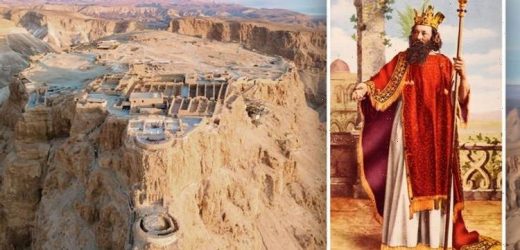Israel Antiquities Authority show off Herodion National Park
When you subscribe we will use the information you provide to send you these newsletters. Sometimes they’ll include recommendations for other related newsletters or services we offer. Our Privacy Notice explains more about how we use your data, and your rights. You can unsubscribe at any time.
King Herod I is among the most reviled villains of the Bible’s New Testament. According to the Gospel of Matthew, Herod ordered a massacre of newborn babies upon learning of Jesus Christ’s birth in Bethlehem. Matthew 2:16 reads: “When Herod realized that he had been outwitted by the Magi, he was furious, and he gave orders to kill all the boys in Bethlehem and its vicinity who were two years old and under, in accordance with the time he had learned from the Magi.”
Although historians and theologians alike have argued about the historicity of this particular event, the archaeological record of his existence is indisputable.
Herod is generally believed to have lived between 74 and 4 BC and ruled over the independent Kingdom of Judea, despite the looming shadow of Rome.
Besides the evil deeds described in the Bible, Herod is regarded as one of Judea’s most prolific builders, whose magnificent projects are still enjoyed today.
Herod is remembered for expanding the Temple in Jerusalem (516 BC to 70 AD), the maritime city of Caesarea and the mountain fortress of Masada on the eastern edge of the Judean Desert.
The latter, in particular, has provided historians and archaeologists with tantalising evidence of King Herod’s life.
According to Tom Meyer, a professor in Bible studies at Shasta Bible College and Graduate School in California, US, an excavation at the site revealed a 2,000-year-old inscription bearing the king’s name.
The Bible expert told Express.co.uk: “The first ever inscription with the full title of the most infamous king of the New Testament has been found by archaeologists.
“Ehud Netzer, who discovered the tomb of Herod the Great at the Herodium, has also found an inscription bearing the infamous king’s name at Masada.”
Masada is an impressive fortification build atop of a 1,33ft-tall rock plateau near Israel’s modern-day border with Jordan and the western shores of the Dead Sea.
The easily defensible position is believed to have been constructed between 37 and 31 BC, and played a critical role more than 100 years later during the First Jewish-Roman War.
Professor Meyer said: “Herod was well aware of the strategic advantages to controlling Masada.
“He chose the site as one of his five strongholds and, according to Josephus, as his winter palace.
“During Herod’s reign, luxurious palaces were built on the plateau around 35 BC, in addition to storerooms, a synagogue, massive cisterns, and a casemate wall around the plateau’s perimeter.
“In 1996 Netzer and his team discovered a cave near the synagogue on the fortress’ plateau.”
This particular cave appears to have been used as a rubbish dump, as evidence by the rubble discovered within.
And yet, among the rubble, the archaeologists unearthed a number of large, broken vessels known as amphorae, as well as the preserved remains of foods.
These included the shells of eggs and nuts, as well the pits of olives and pits.
According to Professor Meyer, the rubbish may have been left behind by a crew of some 100 people who guarded the fortress.
He said: “Inscribed on one of the broken pieces of amphorae in Latin was the name and title ‘Herod, King of Judea’.
“The cone-shaped, two-handled jug upon which the inscription was found originally held around 20 gallons of wine and dates to around 19 BC.
“The wine was likely exported to the Holy Land from Italy. This discovery related to Herod the Great once again testifies to the reliability and historical accuracy of the Bible.”
Professor Meyer strongly believes the discovery validates the Bible’s historical track record and proves “Herod was a real person who, as the Gospels spell out, really was the ruler of Judea who ordered the massacre of the innocents in a vain attempt to eliminate his newborn rival, Jesus the King of the Jews”.
Many historians, however, have challenged this theory over the years.
From a purely Biblical perspective, the so-called Massacre of the Innocents does not feature in any of the other three gospels.
The massacre was also not recorded by the Jewish historian Flavius Josephus, who penned the 20-volume Antiquities of the Jews.
In his 2013 book Born of a Virgin? Reconceiving Jesus in the Bible, Tradition and Theology, Andrew Lincoln argued the story may have been modelled on events in Exodus.
He wrote: “The episode of Herod’s killing of the baby boys in order to be rid of the child born king od the Jews (2.2-12) is modelled on Pharaoh’s attempt to kill all the male Israelites babies.”
Other scholars, such as Everett Ferguson, have argued that if a massacre was carried out in the town of Bethlehem, only a small number of children was killed – not enough for Josephus to be aware of.
Source: Read Full Article








